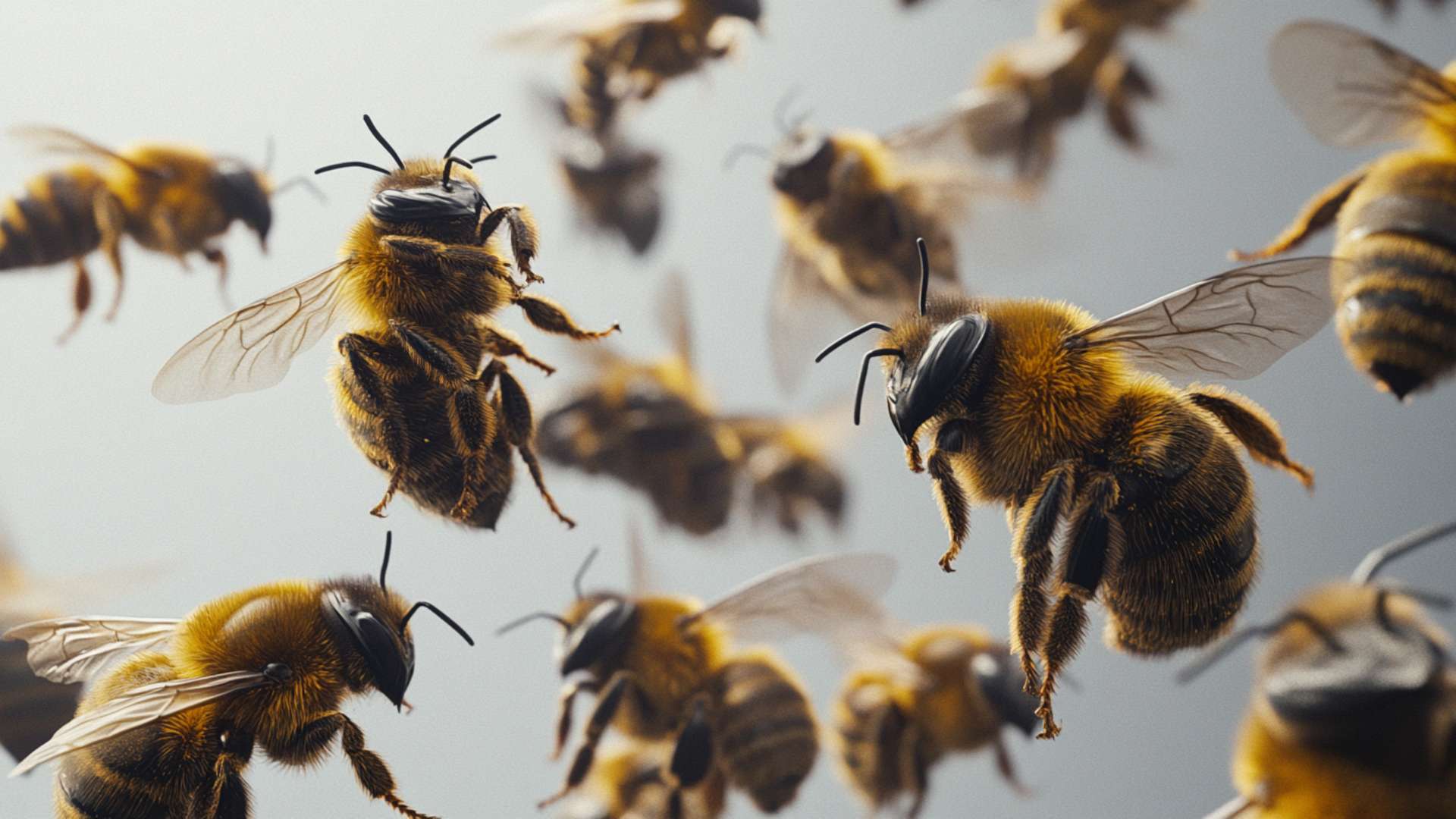Bees, those small insects in gardens, fascinate humans with their social structures and vital role in pollination. Yet, a mysterious aspect of these creatures is milk-making bees.
Yes, you read that right – there are bees that produce milk! This article explores the fascinating world of bees and reveals the secrets of milk-making marvels.
Fascinating world of bees
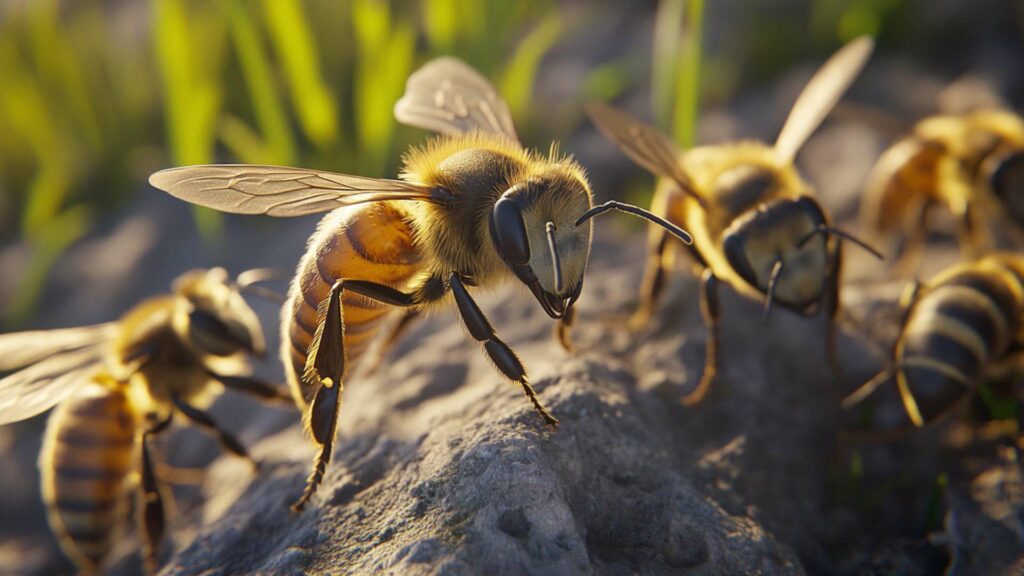
The world inhabited by bees is nothing short of astonishing. The bee family boasts over 20,000 known species worldwide. Each species with distinct characteristics and behaviors, showcasing remarkable diversity.
The most famous bee species is the honeybee (Apis mellifera), known for making honey and pollinating. Honeybees live in complex colonies, led by a queen bee who lays eggs, while worker bees gather nectar to make honey.
Bumblebees (Bombus spp.) are important pollinators, contributing to biodiversity. Bumblebee colonies have interesting social structures. The queen bee starts a colony, and worker bees gather pollen and nectar for colony growth.
Unveiling the mystery of milk-making bees
Let’s explore the mysterious world of milk-making bees that has fascinated scientists and the public. Certain bee species have developed the unique ability to produce special secretions. These are known as “bee milk” or “royal jelly.”
Meet the remarkable stingless bees, part of the Meliponini tribe, known for their special traits. These bees are notable for their distinct features and can be found in tropical and subtropical regions worldwide.
Stingless bees are crucial in native cultures, esteemed for their honey and medicinal uses. Another group of milk-producing bees belongs to the Trigona species.
These fascinating creatures have specialized glands for milk synthesis located in their heads. Bee milk is packed with proteins, lipids, amino acids, vitamins, and minerals, benefiting both bee larvae and humans.
Researchers are exploring the potential health benefits of bee milk. They are considering its use as a supplement or in topical applications. However, scientific studies on its effectiveness are still limited and ongoing.
Let’s explore the world of milk-making bees. Uncover the secrets behind their ability to produce this nutrient-rich substance. Prepare to be amazed by the wonders that these tiny creatures hold within their hives!
Overview of Bee Species
Honeybees (Apis mellifera)
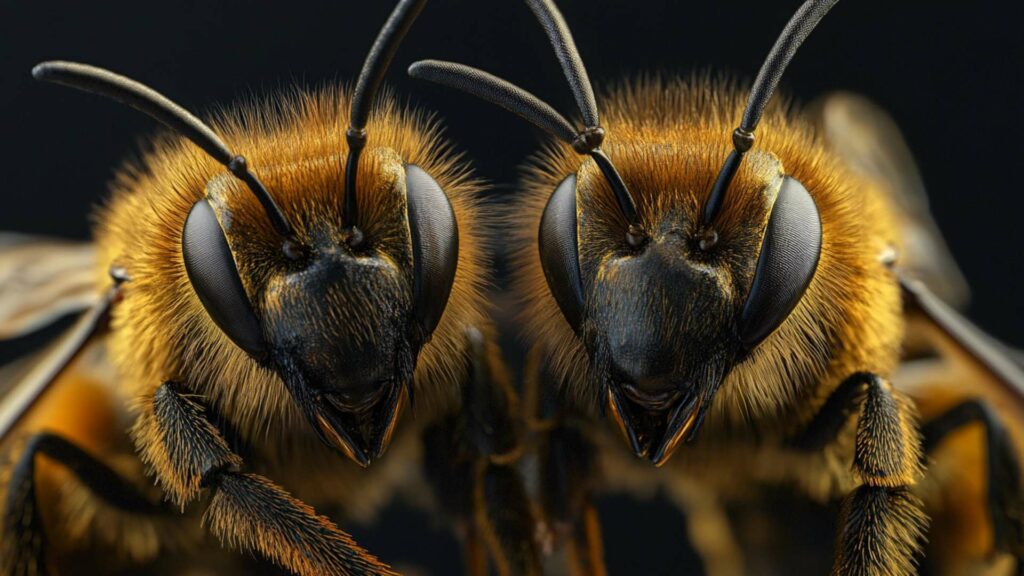
When it comes to the world of bees, one species that instantly comes to mind is the honey bee (Apis mellifera). These industrious creatures are renowned for their role in honey production and are beloved for their sweet nectar.
Honeybees have an intricate social structure and work within a fascinating system of labor division. In a honeybee colony, thousands of individuals work together harmoniously.
The social structure revolves around specific roles assigned to different bees. One crucial role is that of worker bees, which make up the majority of the colony’s population.
These tireless workers gather nectar from flowers and convert it into honey through an intricate process. They also serve as nurses, caring for the brood and maintaining the hive’s cleanliness.
Bumblebees (Bombus spp.)
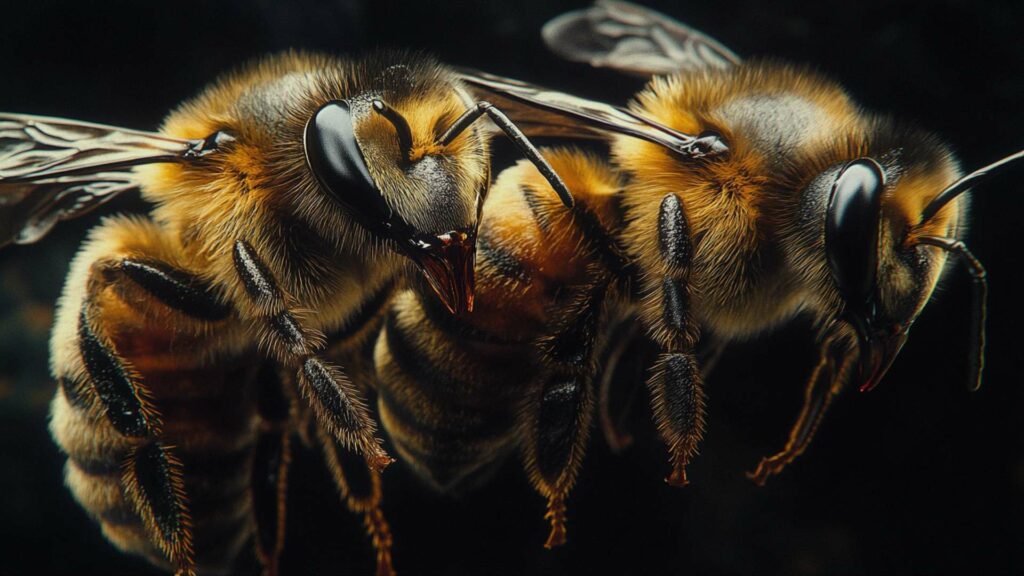
Another important group within the bee family is bumblebees (Bombus spp.). While not big honey producers like honeybees, bumblebees are crucial for pollination. They collect nectar from flowers. In the process, unknowingly move pollen between flowers.
This accidental pollination makes them valuable contributors to plant reproduction and diversity. Bumblebees have distinctive nesting habits compared to other bee species.
Unlike honeybees, they do not construct elaborate hives with hexagonal cells. Bumblebee colonies usually nest underground or in abandoned burrows or grassy tussocks.
Their colonies are generally smaller than those of honeybees, consisting of only a few hundred individuals. Colony dynamics among bumblebees involve an interesting life cycle with annual variations.
Every year, new queens emerge from winter hibernation to establish colonies by finding nesting sites. After mating with males, the males die, and the fertilized queens hibernate until the next cycle begins.
Honeybees and bumblebees are fascinating species with distinct roles in their ecosystems. Honeybees contribute to honey production and pollinate various plant species.
Bumblebees excel in pollination and have unique nesting habits with an annual life cycle. Together, these incredible creatures demonstrate nature’s intricate tapestry of biodiversity and interdependence.
The Enigmatic Milk-Making Bees
Meliponini – Stingless Bees

Stingless bees, also called Meliponini, are intriguing bees that captivate researchers and enthusiasts. They have distinct features that differentiate them from honeybees.
Stingless bees, unlike honeybees (Apis mellifera), don’t have a stinger. Making them gentle and non-aggressive toward humans. There are about 500 species in tropical regions globally. These bees are vital for pollination and maintaining ecosystems.
Beyond their ecological significance, stingless bees hold immense cultural value for indigenous communities. In cultures worldwide, people consider them sacred. This is due to their connection with ancient myths and folklore.
These bees symbolize fertility, abundance, and harmony with nature. Indigenous communities traditionally collect stingless bee honey. Also known as “bee mother’s milk,” for its medicinal and spiritual significance.
Trigona spp.
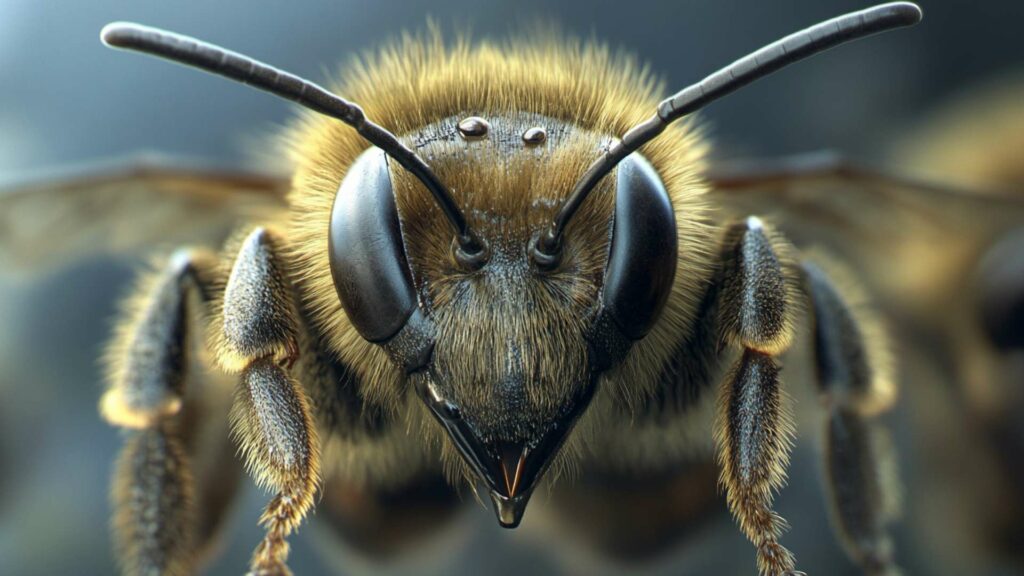
Another set of milk-making bees is Trigona, often called trigonine or stingless honeybees. These small-sized bees exhibit an intriguing milk production process unique to their species.
Trigona species have special glands that make a nutritious substance called “bee milk.” This secretion is packed with compounds crucial for bee larvae development. These compounds include proteins, vitamins, lipids, and minerals. The composition of trigonine bee milk differs between species and even within colonies.
Researchers found that it has vital amino acids like lysine and arginine, plus beneficial fatty acids. This nutritious substance is crucial food exclusively for young larvae during their development.
Studies on bee milk’s health benefits show promising properties. Research indicates compounds in bee products, like royal jelly in honeybee milk, may help lower blood pressure and blood sugar.
Researchers are studying royal jelly supplements for potential health benefits. Such as relieving premenstrual syndrome symptoms and supporting bone metabolism. But, more rigorous scientific studies are needed. This is due to the unknown effects and benefits of bee milk and royal jelly consumption on human health.
Extracting trigonine bee milk is challenging because each stingless bee produces small quantities. Researchers use advanced techniques like microdissection or mass spectrometry. This helps to collect tiny amounts for their investigations.
Despite challenges, scientists continue exploring stingless bees’ milk production. Stay tuned for lesser-known bees producing remarkable “bee milk”!
Bee Milk: Nectar or Secretion?
Unveiling the Mysteries of Bee Milk
In the bee world, there’s a substance that intrigues researchers: bee milk. What is this mysterious substance in honey bee biology?
Is it derived from nectar or a unique secretion produced by certain bee species? Let’s embark on a journey to uncover the truth behind this fascinating phenomenon.
Differentiating between Bee Milk and Honey
Bee milk and honey are crucial for bees, but they’re different. Honey, that sweet golden liquid, is made by honey bees (Apis mellifera).
Honey comes from flower nectar stored in honeycombs for energy. Bee milk, also called royal jelly, nourishes developing larvae.
Sources and Extraction Methods
Bee milk, or royal jelly, can be collected by extracting it from brood cells in beehives. These cells are chosen for their high concentrations of royal jelly. Which nurse bees use to feed growing larvae.
Beekeepers use specialized tools to delicately extract royal jelly. This ensures minimal disruption to the colony and larval development. Researchers studying its potential health benefits use advanced techniques to obtain larger quantities.
Scientists often use grafting methods. These help to transfer larvae into artificial queen cells in controlled labs. This allows for closer monitoring of the production process. It also ensures healthy subjects for research.
The Significance of Bee Milk for Larvae Development
Bee milk is crucial for developing larvae, especially for creating queen bees. When a colony needs a new queen, nurse bees feed specific larvae only fresh royal jelly.
This special diet causes physiological changes, turning regular female larvae into potential queens. Royal jelly’s blend of nutrients supports ideal growth and development. These nutrients include proteins, amino acids, vitamins, and minerals.
Studies highlight the advantages of royal jelly for growing bees. This is due to it being packed with amino acids. This includes the important major royal jelly protein (MRJP), which provides distinct properties.
These proteins aid larval growth and boost their immune systems. This in turn helps in defending against various pathogens. Bee milk is a unique secretion crucial for bee colonies’ survival and growth.
Unlike honey, bee milk provides vital nutrients for larvae’s growth and transformation. Packed with proteins and amino acids, it ensures the health of future bee generations.
The Lesser-Known Bee Milk Producers
Stingless Bees: Tetragonula spp.Distinctive traits and behavior patterns
Stingless bees, Tetragonula species, are intriguing bees. They produce milk-like substances for their larvae. These small creatures have unique traits and behaviors. These traits distinguish them from other milk-making bees.
Stingless bees, unlike honeybees (Apis mellifera), are smaller, measuring only 2 to 5 mm. They build nests uniquely, creating intricate structures from wax and resinous materials.
One remarkable characteristic of Tetragonula stingless bees is their social structure. They live in large colonies, comprising thousands of individuals working together harmoniously.
In developing queen bee colonies, labor division is highly organized. Each bee has a specific task for the hive’s smooth functioning. Worker bees forage for food and produce royal jelly, a crucial component of bee milk.
Comparative analysis with other milk-making bees:
Stingless bees, like Tetragonula species, differ from other milk-producing bees. They have smaller colonies, and the composition of their bee milk may vary slightly.
Tetragonula spp.’s bee milk has a unique fatty acid composition compared to honeybee milk. This leads to potential health benefits. These are associated with consuming milk from stingless bee species.
Mason Bees: Osmia spp.Unconventional approach to larval nutrition
Mason bees, scientifically Osmia spp., are lesser-known bee milk producers. Unlike honeybees or stingless bees, mason bees have an unconventional feeding strategy. They don’t produce bee milk through specialized glands. Instead, they use an alternative approach to larval nutrition.
The female mason bees lay their eggs in pre-existing cavities such as hollow stems or holes in wood. They then gather a mixture of pollen and nectar and place it in the cell alongside the egg.
This combination of pollen and nectar serves as food for the developing larvae. Interestingly, this method eliminates the need for producing traditional bee milk. Advantages and limitations of their feeding strategy
Mason bees have a unique feeding strategy with both advantages and limitations. Unlike other milk-making bees, they provide a ready-made food source for their young. This saves energy that would otherwise be used for producing and secreting bee milk. This efficient approach helps them allocate resources more effectively.
This strategy of mason bees may not offer the same benefits as the traditional royal jelly. The royal jelly from honeybees contains major royal jelly proteins. These have demonstrated potential health benefits when consumed by humans.
Mason bees offer a pollen-nectar mixture that has essential nutrients for larval development. However, it lacks some compounds found in traditional bee milks. Stingless bees, like Tetragonula spp., produce unique bee milk with distinct traits. Mason bees (Osmia spp.) take a different approach to larval nutrition. Each group has its advantages and limitations in producing “bee milk.” The interplay between these creatures showcases the intricate marvels of nature. Further ensuring the survival and growth of their young.
Beekeeping Practices with Milk-Making Bees

Stingless Bees: Tetragonula spp.
Stingless bees, like Tetragonula species, are popular in beekeeping. This is due to their unique milk-making abilities. Some beekeepers successfully maintain colonies for harvesting bee milk. Specially designed hives with small entrances mimic their natural nesting habits.
Hive placement is crucial for stingless bees, sensitive to temperature and humidity changes. Gathering bee milk from them demands patience and precision.
Beekeepers delicately open milk-filled brood cells. The further extract it with gentle tools or techniques that don’t harm the bees. This is typically done when nurse bees are tending to the larvae.
Mason Bees: Osmia spp.
Mason bees have a distinct way of nourishing their larvae. While they don’t produce conventional milk, they contribute significantly to pollination. This helps in benefiting specific crops. Beekeepers caring for mason bees prioritize providing suitable nesting sites. They do this rather than focussing on collecting bee milk.
To boost mason bee numbers, we provide special nests. These nests are made from materials like cardboard tubes or drilled wooden blocks. These nests protect larvae in winter. They also create the right conditions for successful reproduction.
Conclusion
Exploring milk-making bees shows a fascinating side beyond honey. Tetragonula stingless bees, with careful hive management, provide unique bee milk. Mason bees are vital for pollination and can be encouraged with proper nesting sites.
Learning about beekeeping practices for milk-making bees gives us insight into their world. This also allows for us to understand their impact on the ecosystem. Whether nurturing larvae or aiding pollination, these bees amaze us with their ingenuity.
The next time you see a honey bee hive or a busy bee collecting nectar, pause to appreciate the wonders. The next time you see a honey bee hive or a busy bee collecting nectar, pause to appreciate the wonders. The bee world is awe-inspiring. From hardworking honeybees to the magical milk-making abilities of stingless bees. It reminds us of nature’s marvels and the need to protect these remarkable creatures for future generations.
Neutralize Bees with D-Termination: Las Vegas’ Premier Pest Control!

Wrestling with bee issues on your Las Vegas property? Count on D-Termination for assistance. Our adept team specializes in eradicating bee infestations, restoring comfort and peace to your space. Say farewell to bees—opt for D-Termination for effective pest control today!
Contact us at 702-919-6310 or visit dtermination.com to schedule your bee control service and reclaim your space from these troublesome insects.
Frequently Asked Questions:
Yes, however, it is not the same type of milk that you may consume.
This milk is known as “bee milk” or “royal jelly.”
Almond milk is not made from bees.
Bees are not involved in the production of almond milk.

